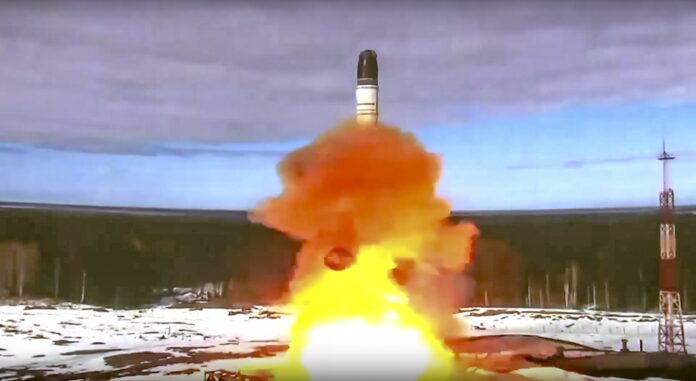President Vladimir Putin has once again promoted Russia’s nuclear might against the backdrop of the Ukraine conflict, saying on Wednesday that a new ballistic missile system should make Moscow’s enemies stop and think.
Announcing Russia’s invasion of Ukraine eight weeks ago, Putin warned the West that any attempt to get in its way “will lead you to such consequences that you have never encountered in your history”. Days later, he ordered Russia’s nuclear forces to be put on high alert.
United Nations Secretary-General Antonio Guterres said last month that “the prospect of nuclear conflict, once unthinkable, is now back within the realm of possibility”.
Here is how Russia’s chain of command would work in the event of a nuclear weapon launch.
A 2020 document called “Basic Principles of State Policy of the Russian Federation on Nuclear Deterrence” says the Russian president takes the decision to use nuclear weapons.
A small briefcase, known as the Cheget, is kept close to the president at all times, linking him to the command and control network of Russia’s strategic nuclear forces. The Cheget does not contain a nuclear launch button but rather transmits launch orders to the central military command – the General Staff.
NATO to provide Ukraine with equipment to protect against chemical, biological and nuclear threats: Stoltenberg – Mar 24, 2022
The Russian General Staff has access to the launch codes and has two methods of launching nuclear warheads. It can send authorisation codes to individual weapons commanders, who then execute the launch procedures. There is also a back-up system, known as Perimetr, which allows the General Staff to initiate the launch of land-based missiles directly, bypassing all the immediate command posts.
After Putin said on Feb. 27 that Russia’s deterrence forces – which include nuclear weapons – should be put on high alert, the defence ministry said the Strategic Missile Forces, the Northern and Pacific Fleets, and the Long-Range Aviation Command had been placed on “enhanced” combat duty, with reinforced personnel.
Trending Stories
‘Living in pain’: Canadians travel across the world to avoid surgery backlog
Pierre Poilievre among the dozens of MPs with rental property amid housing crunch
The term enhanced, or special, combat duty does not appear in Russia’s nuclear doctrine, leaving military experts puzzled over what it might mean.
Pavel Podvig, a senior researcher at the United Nations Institute for Disarmament Research in Geneva, said on Twitter that the order might have activated Russia’s nuclear command and control system, essentially opening communication channels for any eventual launch order. Alternatively, he said, it might just mean the Russians had expanded the staff at their nuclear facilities.
Radiation at Ukraine’s Chornobyl “quite normal” after Russian troop withdrawal, says IAEA chief – Apr 1, 2022
The 2020 doctrine presents four scenarios that might justify the use of Russian nuclear weapons:
The use of nuclear weapons or weapons of mass destruction against Russia or its allies;Data showing the launch of ballistic missiles aimed at Russia or its allies;An attack on critical government or military sites that would undermine the ability of Russia’s nuclear forces to respond to threats;The use of conventional weapons against Russia “when the very existence of the state is in jeopardy”.
The Federation of American Scientists estimates that Russia has 5,977 nuclear warheads, more than any other country. Of these, 1,588 are deployed and ready for use. Its missiles can be fired from land, by submarines and by airplanes.
Putin oversaw a coordinated test of Russia’s nuclear forces on Feb. 19. On April 20, he was shown on TV being told by the military that the intercontinental ballistic missile Sarmat, which has been under development for years, had been successfully test-launched for the first time.
READ MORE: Ukraine investigating reports Russia may have used chemical weapons in Mariupol
Russia’s nuclear forces will start taking delivery of the new missile “in the autumn of this year”, Tass quoted a senior official as saying on Wednesday.
The United States, for its part, last month postponed a routine test launch of its Minuteman ballistic missile in an apparent effort to lower tensions with Russia.
No. To date, the only use of nuclear weapons during conflict was in 1945, at the end of World War Two, when the United States dropped atomic bombs on the Japanese cities of Hiroshima and Nagasaki.
(Reporting by Crispian Balmer; Editing by Kevin Liffey)
© 2022 Reuters



